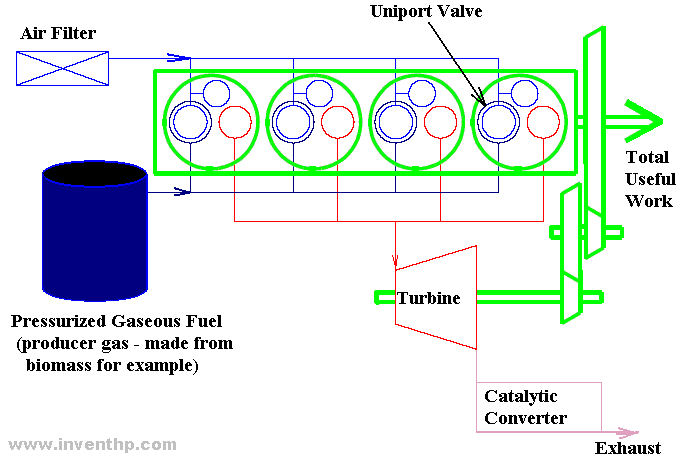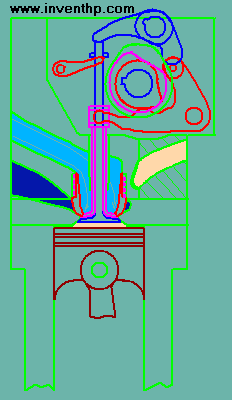As
crude oil gets more expensive, research for engines that can
use fuel made from biomass is
occurring. Some of these fuels are being made or collected today. Producer gas [other names or other similar fuels: town gas, coal gas, hygas, manufactured gas, syngas, SNG, woodgas, holzgas, air gas] (approximate
molar analysis ~ 20% H2, 20% CO, 2% CH4,
42% N2, 8% CO2, 8% H20) is made
from wood or other organic materials in gasifiers.
Biogas is formed in anaerobic digesters where microscopic organisms in
the absence of air act on starches and other organic compounds to
produce methane and carbon dioxide (approximate molar analysis
60% CH4, 30% CO2, 10% N2). The
proposed engine to burn one of these gases will mechanically
be
much like the "Dual Pressure Intake Engine". The below diagram and
animation describe the operation of this 'Green' engine.
Diagram
of Producer Gas Engine or Biogas
(The
engine could be SI or CI)

Producer Gas or Biogas Engine
(With
Low Pressure Direct Induction Fuel System)
In
the animation to the right the:
Light
blue = air intake (at 1 atm)
and
Navy blue
= producer gas (storage pressure ~ 4 - 10 atm)
Using
an induction system
similar to the Dual
Pressure Intake
Engine but with the fuel and air in separate intake runners, one can nearly double the
volumetric efficiency of a regular Producer Gas Engine without using a
supercharger or turbocharger. This would be accomplished by
first filling the cylinder with
ambient pressure
air and then allowing the gaseous fuel, producer gas,
to top off the cylinder to a pressure of about 2 atm. Increasing volumetric efficiency of
an engine by taking advantage of the pressurized fuel is important
since producer gas have a low heat content
compared to natural gas for example.
Also, the
kinetic energy of the fuel/air mix will be high due to the large pressure
differential between the induced air (~ 1 atm) and the producer gas's storage pressure
(4-10 atm). This should help the charge burn quicker and more efficiently.
|  |
